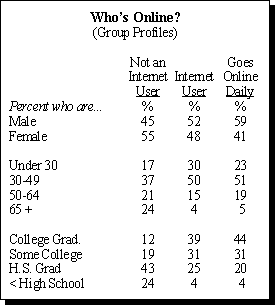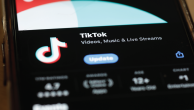As the number of Americans using Internet technology continues to grow, people increasingly turn to the Internet to do research for work, get entertainment and travel information, shop, and catch up with friends and family. This wide range of activities reflects the expanding Internet population, which is beginning to look like a broader cross-section of the American public.

Over the last three years, the number of Americans who own computers has grown to 43% from 36%, and the percentage using the Internet and email has increased even more. Today, 41% of Americans go online — up from just 14% in 1995.1 One-third of Americans (35%) use email, more than triple the number three years ago (10%).
Unlike many technologies developed in recent decades that are used primarily in the workplace, the Internet is taking root right at home. Fully 74% of people who use the Internet go online at least some of the time from home, and nearly half (49%) connect to the Internet only from home. This is more than the total number of people who go online at work exclusively or some of the time (38%). Similarly, asked if they went online just yesterday, 43% of Internet users said they had — 32% said they went online from home just yesterday.

Some 12% of Americans — 22 million people — go online everyday, compared to just 3% three years ago. Internet users tend to go online throughout the day, for relatively brief periods of time. One-in-four (25%) Internet users say they generally go online during the daytime, and nearly as many favor the dinner (22%) or late night hours (22%). Fewer go online during the morning hours (16%).
The typical user spends an hour or less online on any given day. Among those who used the Internet the day before they were interviewed, 29% were online for a half-hour or less, while 41% were online for up to one hour. The remaining 30% spent more than an hour online throughout the day.
Most Internet users say they are happy with the amount of time they spend online and would miss the Internet if it were gone. Some 63% say they spend about the right amount of time online, while 27% say they want to spend more time on the Internet. People who go online everyday are more satisfied than those who do not with the amount of time they spend online — one-third of those who are not daily Internet users say they wish they could spend more time online, compared to only 15% of everyday users.
The New Internet Users
Reflecting the steady growth of the Internet in America, 46% of users started going online just within the last year. And as the online population expands, there are signs that the Internet — used by a relatively small and elite group several years ago — is beginning to reach a broader cross-section of the public.

Fully 40% of those who started going online within the past year never attended college, which is nearly twice the number as among experienced Internet users (22%). Similarly, 23% of new users have household incomes below $30,000 a year, compared to just 16% of those who have been online for more than a year.
This growth in the online population is changing the way Americans use the Internet. For example, new Internet users go online less often than those who started using the Internet more than a year ago. Four-in-ten experienced users (40%) go online everyday, twice the number of new users who do so (19%). And on days when they do go online, 53% of experienced users connect to the Internet several times during the course of the day, compared to just 34% of new users.
Not only do new Internet users go online less often, but when they do, it’s typically for fun, not for work or research. Experienced users are more or less evenly divided between those who go online all or mostly for pleasure (39%), all or mostly for work (30%), or both (31%). In contrast, most new Internet users say they go online all or mostly for pleasure (52%), while 25% go online for work and 22% for both. But just 26% of new users say they would miss the Internet a lot of they could no longer go online, compared to 49% of experienced users.
Despite these substantial changes in the Internet population, it is still a long way from mirroring the country as a whole. The 74 million Americans who go online remain substantially younger, better-educated and more affluent than the U.S. population at large. Fully 39% of Internet users are college graduates, for example, compared to just 22% of all Americans. Similarly, 80% of Internet users are under age 50, compared to 63% of all Americans.
An Information Source

People increasingly use the Internet as a source of information. Nearly half of all Internet users (47%) now go online at least once every week to get information for their work or job, while 38% go online as often to get news and information about current events and 35% to get information about hobbies, movies, and other entertainment-related activities. Entertainment is an especially big draw for younger users: 47% of those under age 30 go online every week for information about hobbies, movies and entertainment, compared to 23% of those over age 50. More than one-in-four Internet users (28%) go online every week to get stock market updates or buy stocks and bonds.
As more people have gone online and more websites have become available, the number of Internet users who go online for a range of information has grown substantially. Fully 73% now go online at least occasionally for entertainment-related information, for example, up from just 44% in 1995. Similarly, 68% go online for vacation or travel information, compared to just 27% three years ago.
But getting information off the Internet is not always easy. Most Americans who go online say they have been frustrated trying to find something on the Internet (60%), by the speed of their Internet connection (59%) and by the speed of their searches (56%). These frustrations are not due to a lack of experience. In fact, experienced users — who go online more often — express even more frustration than new users in each of these areas.
At the same time, the advantages of the Internet outweigh these disadvantages for most users. More than three-quarters (77%) of all Internet users — experienced and inexperienced alike — disagree with the statement that finding information online is so hard that it’s usually not worth the time.

More than half of Internet users (58%) have bookmarks that save one or more favorite websites — 70% of old users have bookmarks compared to 44% of new users. Fewer Internet users have listened to audio clips (46%) or watched video clips (46%) online.
A Shopping Place
Even before the 1998 Christmas season, more than one-in-ten Americans (13%) had purchased goods or services online. One-third (32%) of online users had done so. This represents a significant increase from 1995 when only 8% of online users reported ever having shopped online. The increase in online shopping over the last three years is most pronounced among men, those over age 50 and college graduates.

Five percent of today’s online users report buying something online within the past week, 11% in the past month, and 16% more than one month ago. Online shopping is much more prevalent among men than women — 38% of men vs. 25% of women who go online have purchased goods or services there. Internet users ages 50-64 are the most likely to shop in this fashion (38%). Those under age 30 are the least likely — only 23% have ever shopped online. More educated online users and those with higher incomes shop online at higher than average rates.
Among those who have shopped online, a narrow majority report that they were at least somewhat worried about the security of their credit card numbers when doing so. However, only 17% worried a lot about security issues, another 38% worried a little. Fully 44% say they did not worry at all.
Among the many Internet users who have never purchased goods or services online, most (61%) say they have been reluctant to do so because they were worried about the security of their credit card numbers; but 36% say security concerns have not been an impediment for them.
Connecting With Friends, Family
An overwhelming majority of the online public (85%) use email, mostly to communicate with their family and friends. Email is popular among all groups of Internet users — men and women, young and old. Most of those who email their family and friends say they communicate with them more often now that email is available (61%), while 37% say email has made no difference. Among those who use email at work, 36% say it has led to more honest communication in the workplace, 52% say it has made little difference.
Most people who have email check their it at least once everyday (59%), and 45% say they used email just yesterday. On a typical day, email users send about six messages and receive about 12 messages.
But even as the Internet provides an instantaneous link to people throughout the world, it usually does not bring together people who do not know each other already. For example, just 24% are on an email list-serv, an electronic mailing list that allows people with common interests to send messages to everyone on the list. Similarly, 22% say they regularly communicate with others through chat groups or discussion lists on the Internet.
Just 23% of Internet users have met a new friend online. Even fewer have expressed a political or social opinion through an email list or on an online bulletin board (15%) or participated in an online discussion about politics (11%). None of these activities are substantially more popular among Internet users than they were three years ago.




